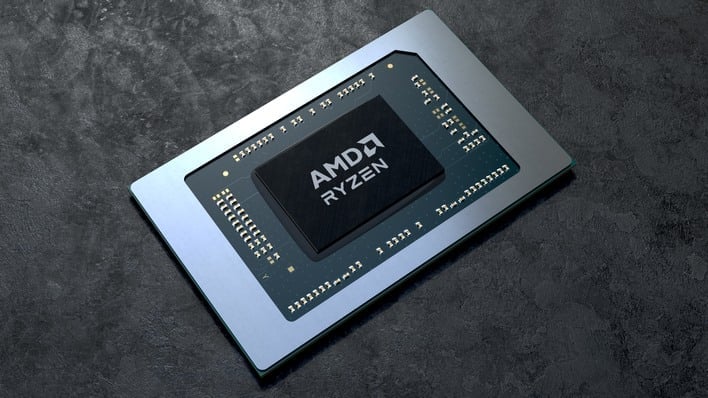AMD Kraken Point Processors To Allegedly Feature Four Zen 5 And Four Zen 5c Cores
Right now, AMD's mobile processors range from the lowly Ryzen 7020 series, codenamed Mendocino, all the way up to the powerful (and power-thirsty) Ryzen 7045 series, known as Dragon Range. Nestled in between, you have the Ryzen 7035 series, Rembrandt, serving mainstream customers, and then the Ryzen 7040 and 8040 series, Phoenix and Hawk Point, serving the premium mobile segment. That's your thin & light executive laptops.
Kraken is an interesting beast. According to leaks, it'll be based on Zen 5 CPU cores, RDNA 3.5 GPU cores, and XDNA 2 NPU hardware, all fabricated on TSMC's N4 process. Sounds a lot like Strix Point, right? Except Kraken Point is going to be a smaller chip, with just eight CPU cores instead of Strix Point's twelve. It'll also have a smaller GPU, although the NPU performance seems to be in the same range as Strix Point.
In a reply to that reveal, Everest also announced that the Kraken Point die will in fact only have four RDNA 3.5 WGPs on it. That's equivalent to 8 CUs, or 512 shader processors. Unless RDNA 3.5 drops the dual-issue capability of the original recipe, those four WGPs still result in a GPU with some 5 TFLOPs of peak theoretical FP32 compute throughput, so this is still a pretty damn potent integrated graphics part. Indeed, it's the same configuration as you'd find in a Ryzen 7035 processor or the Steam Deck—just with the latest graphics architecture instead of RDNA 2.
Strix Point looks primed for premium laptops, and Strix Halo could introduce a whole new class of PC product. Kraken, on the other hand, looks tailor-made for ultrathin laptops and handheld gaming machines. Ayaneo is fond of reducing CPU clocks and disabling cores on the chips in its handhelds to allow the GPU to hog more of the TDP for itself; it's easy to imagine a Kraken CPU with two, three, or even all of its Zen 5 cores disabled to rely on the slower (but more efficient) Zen 5c cores in a handheld.
These parts will probably be announced at CES for a launch early next year, so we won't see them anytime soon. As usual, AMD is expected to debut its Zen 5 core architecture on its desktop platform with its Granite Ridge CPUs; those may just show up for Computex this year, in May.
If the roadmaps leaked by the usual suspects are to be believed, Mendocino and Rembrandt will continue at the bottom of the product stack next year, supporting Escher, which appears to be a refresh of Hawk Point. We've talked quite a bit recently about Strix Point and Strix Halo, the chips that will handle Premium mobile and "Elite mobile," respectively, but what's replacing Hawk Point? Apparently, a new part called "Kraken Point".
Kraken is an interesting beast. According to leaks, it'll be based on Zen 5 CPU cores, RDNA 3.5 GPU cores, and XDNA 2 NPU hardware, all fabricated on TSMC's N4 process. Sounds a lot like Strix Point, right? Except Kraken Point is going to be a smaller chip, with just eight CPU cores instead of Strix Point's twelve. It'll also have a smaller GPU, although the NPU performance seems to be in the same range as Strix Point.
The latest leak from respected rumormonger Everest (@Olrak29_ on Xwitter) is that Kraken Point will actually feature just four Zen 5 cores alongside four Zen 5c dense cores. If you haven't been paying attention, AMD has two types of cores now: standard density, and high-density, with the latter indicated by a "c" at the end of the architecture name. The "c" cores offer the same feature set and capabilities as a standard density core, but they don't clock as high, and they're more efficient at lower clocks, leading to improved efficiency.
In a reply to that reveal, Everest also announced that the Kraken Point die will in fact only have four RDNA 3.5 WGPs on it. That's equivalent to 8 CUs, or 512 shader processors. Unless RDNA 3.5 drops the dual-issue capability of the original recipe, those four WGPs still result in a GPU with some 5 TFLOPs of peak theoretical FP32 compute throughput, so this is still a pretty damn potent integrated graphics part. Indeed, it's the same configuration as you'd find in a Ryzen 7035 processor or the Steam Deck—just with the latest graphics architecture instead of RDNA 2.
Strix Point looks primed for premium laptops, and Strix Halo could introduce a whole new class of PC product. Kraken, on the other hand, looks tailor-made for ultrathin laptops and handheld gaming machines. Ayaneo is fond of reducing CPU clocks and disabling cores on the chips in its handhelds to allow the GPU to hog more of the TDP for itself; it's easy to imagine a Kraken CPU with two, three, or even all of its Zen 5 cores disabled to rely on the slower (but more efficient) Zen 5c cores in a handheld.
These parts will probably be announced at CES for a launch early next year, so we won't see them anytime soon. As usual, AMD is expected to debut its Zen 5 core architecture on its desktop platform with its Granite Ridge CPUs; those may just show up for Computex this year, in May.




